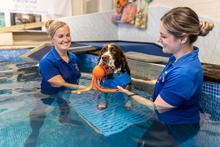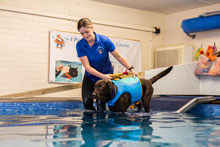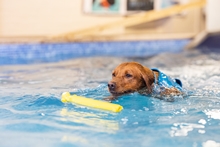




Phone us on 01425 471759 to find out how we can help your pet. Contact Us
Download the 4 Paws Hydrotherapy Fun and Fitness Referral Form
Download the 4 Paws Hydrotherapy Referral Form
Download our Pre-swim Information document
What is hydrotherapy?
Hydrotherapy for small animals is a form of therapeutic exercise carried out in warm water, in a pool or underwater treadmill. The properties of water allow the animal to exercise in a partial or non-weight bearing environment, giving increased circulation to muscles, increased joint flexibility and reduced joint pain. The stabilising and buoyant effects of water allow re-mobilisation of joints which may not be possible when weight bearing out of water.
Water resistance is useful for muscle strengthening and cardiovascular training whilst water pressure can reduce odema and swelling.
Conditions that benefit from hydrotherapy
Most dogs will beneft greatly from hydrotherapy as a form of exercise. Any animal that requires improvements in core strength, proprioception, gait modification, flexions, extension, muscle bulk, cardiovascular and muscle endurance will benefit from hydrotherapy.
Muscle wastage begins within 3 days of any immobilisation so hydrotherapy either in the pool or on the aquatic treadmill helps prevent further weakness or injury through safe exercise.
Conditions that benefit from hydrotherapy are categorised as follows:-
- Orthopaedic
- Neurological
- Soft tissue injuries
- Conditions relating to age (developmental conditions in the young and degenerative conditions in the older animal)
- Degenerative and medical conditions
These conditions include
- Cruciate ligament rupture – post operative or conservative management
- Hip dysplasia
- Elbow dysplasia
- Luxating patella
- Arthritis
- Degenerative myelopathy (CDRM)
- Spinal injuries, including IV disc rupture and fractures
- Spondylosis
- Age related mobility
- Obesity control
The treatment program might require both the pool and underwater treadmill therapy or just one of them. Most often, gait re-education is performed in the underwater treadmill, whereas general strengthening, cardiovascular conditioning and joint mobilisation can be performed in the pool. Generally animals are able to have treatment in the treadmill earlier, post operatively, than they are able to go in the pool. After a few sessions in the treadmill, patients are usually able to progress to the pool. It maybe that they have alternate treatments in the treadmill and pool.
Benefits of swimming in the pool
Swimming in the pool is a reduced-weight bearing form of exercise and is used to treat disease, injury or illness. While swimming most of the muscles used for everyday movement are involved, but joint stress from hard ground is avoided, which helps to reduce pain and allows easier movement. The warm water increases circulation and the flow of blood to the muscles, this in turn helps the muscles relax, reducing pain and stiffness. Improved circulation reduces swelling and the hydrostatic pressure of the water has an anti-inflammatory effect.
The building of muscle mass is one of the main benefits of swimming. Movement in water is more difficult due to the resistance of the water, so is very beneficial in building muscles without pain and if there is a particular limb that has muscle wastage we can swim the animal in such a way to make the target limb work harder, but with pain free movement. You may see an improvement in your pet’s limb measurement after just 5 swims!
Older dogs with hind limb weakness benefit hugely from swimming as we encourage use of the hind limbs with various aids, this in turn increases circulation and also halts further muscle wastage.
All dogs start swimming in a lifejacket, this makes them fully buoyant, as they get more confident we will change that to a float coat, slightly less buoyant and once we feel they are confident and their condition allows, they will just wear a harness. Some of our older patients will always wear a lifejacket, this way they can enjoy their swims, being confident that they will float and we can concentrate of getting those hind legs moving!
The Aquatic Treadmill
The treadmill may not as much fun as the pool, but animals can start their rehabilitation and recovery in the treadmill a couple of weeks before they would be allowed to go in the pool. This is because there is total control over how much support we give the animal, which is determined by how much water is in the treadmill. The speed of the treadmill is adjusted to achieve the correct gait pattern and is ideal for re-educating the movement of the limbs after injury or surgery and is particularly useful for making the transition from water to dry land gradually by increasing the load on the affected limb.
Treatment can be more specific and targeted than in the pool and each session will be adjusted according to the patients’ needs. We also take into account the owners feedback from the previous session, so for example if the patient was slightly stiff following a session in the treadmill, we would either increase the depth of the water, to make the patient more buoyant, or reduce the times in the treadmill, or possibly a combination of both, depending on the injury or condition.
Owners often think that their pets prefer the pool to the treadmill, but this is not always the case and some animals do alternate sessions of pool and treadmill.




